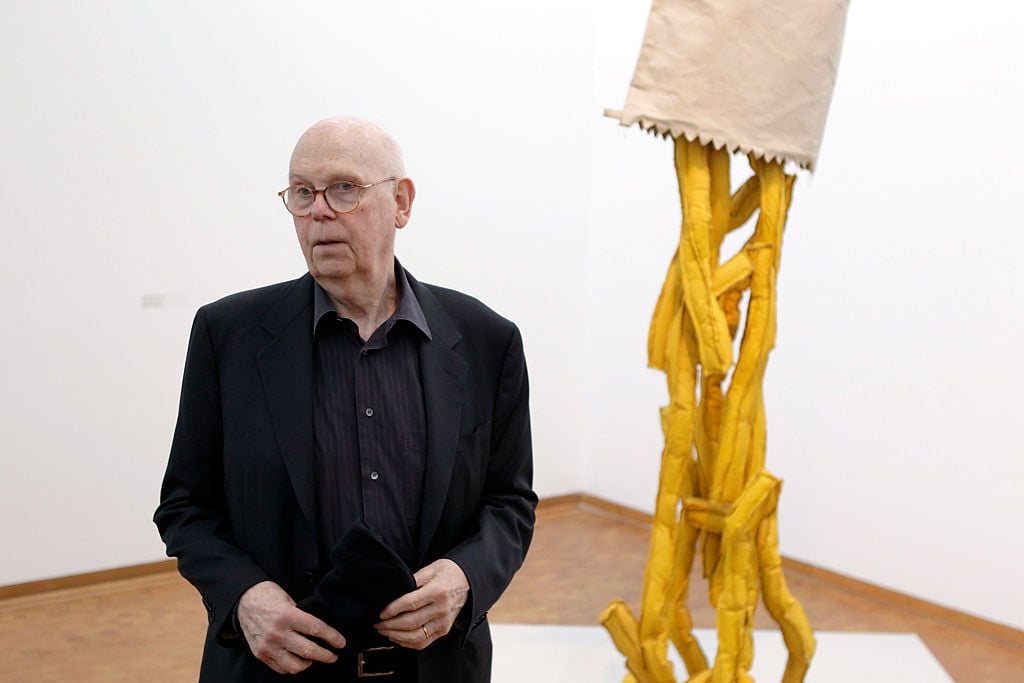
Pop artist Claes Oldenburg, known around the world for his whimsical public sculptures depicting everyday objects—a clothespin, a spoon with a cherry, and even a toilet—has died at age 93.
“I am deeply saddened by the loss of Claes Oldenburg, a great artist, and also a good friend,” his longtime gallerist Paula Cooper told Artnet News. “It was thrilling to work with Claes, whose odd take on things was delightful, and could completely turn one’s mood around.”
When Cooper met Oldenburg, in the mid-1960s, “he was already a noticeably strong force among his peers,” she said. “The strikingly original early work was hugely influential on many artists who were informed by his freedom of thought and radical mode of expression.”
Oldenburg had also worked with mega-gallery Pace, since 1960. In a statement, Pace founder Arne Glimcher said he was “honored to have this great friendship with one of the most radical artists of the 20th century. In addition to his inextricable role in the development of Pop Art, he changed the very nature of sculpture from hard to soft, and his influence can be seen to this day.”
Oldenburg frequently worked with his wife, Coosje van Bruggen, who died in 2009, to produce monumental sculptures, which are now prominently displayed at museums and public gardens all over the world. When he began his collaboration with van Bruggen, “the work became grander and bolder,” according to Cooper.
Installation view of Claes Oldenburg Plantoir (Blue) at Rockefeller Center. Photograph: Steven Probert, courtesy of Claes Oldenburg and Coosje van Bruggen, Paula Cooper Gallery, New York.
The Museum of Modern Art held a second retrospective of Oldenburg’s work in 2013, while the Whitney staged one in 2009, cementing the artist’s status as a Pop art heavyweight ranking alongside Robert Indiana, Roy Lichtenstein, and Andy Warhol.
Oldenburg was born in 1929 in Stockholm. He spent much of his childhood living between the U.S., Sweden, and Norway due to his father’s job as a Swedish diplomat. Oldenburg studied at Yale University, where he focused on writing before attending the School of the Art Institute of Chicago.
In 1956, he moved to New York, where he grew fascinated with the aesthetics of the city streets: display windows, graffiti, advertisements, and trash. A few years later, he opened his show “The Store,” a fully functioning bodega-like shop on Manhattan’s Lower East Side where he sold ice cream, oranges, cigarettes, hats, and shoes—all cast in plaster.
Artist couple Claes Oldenburg (l) and Coosje van Bruggen (r) on 29 May 1987 next to Oldenburg’s sculpture ‘Apple Core’ in the Krefeld art gallery. (Photo by Wilhelm Leuschner/picture alliance via Getty Images)
One of the works from that show, Yellow Girl’s Dress, sold for $1.7 million at Sotheby’s New York in 2008. Noting the rarity of a work from “The Store” on the market, former Sotheby’s contemporary specialist Anthony Grant previously told Artnet News that Claes “was really the sculptor of that first generation Pop movement.”
The highest price to date for an Oldenburg work at auction is $3.6 million, achieved at Christie’s New York in 2015 for Clothespin Ten Foot (1974).
When compared to the lofty prices achieved to date for many of his Pop artist peers, Oldenburg’s market may appear relatively modest. Observers say this is due to a scarcity of preparatory material like drawings and maquettes on the market, as well as the challenge of owning and maintaining a large outdoor sculptures.
As a result, many of his works are collected by institutions. Spoonbridge and Cherry (1985), for instance, a massive sculpture of a spoon with a cherry on top that leans into a lake, is one of his and van Bruggen’s most beloved works and is on long term display at the Walker Art Center in Minneapolis, which owns it.
Claes Oldenburg and Coosje van Bruggen, Spoonbridge and Cherry. Courtesy of the Walker Art Center.
This past spring, a massive garden trowel was unveiled at Rockefeller Center, marking Oldenburg and Van Bruggen’s first public installation in New York City in more than 20 years.
As Artnet News reported this past March, the “comically oversized gardening tool—a 2,300-pound shovel made from aluminum, fiber-reinforced plastic, and steel—stands at more than 23 feet tall, and can withstand winds of more than 120 miles per hour.”
In 2002, a red version of the work was on view as part of the Metropolitan Museum of Art’s exhibition “Oldenburg and Van Bruggen on the Roof.” It was displayed alongside Architect’s Handkerchief (1999), Corridor Pin, Blue (1999), and Shuttlecock/Blueberry Pies I and II (1999). At the time, Plantoir was installed atop the museum’s building against the backdrop of Central Park.